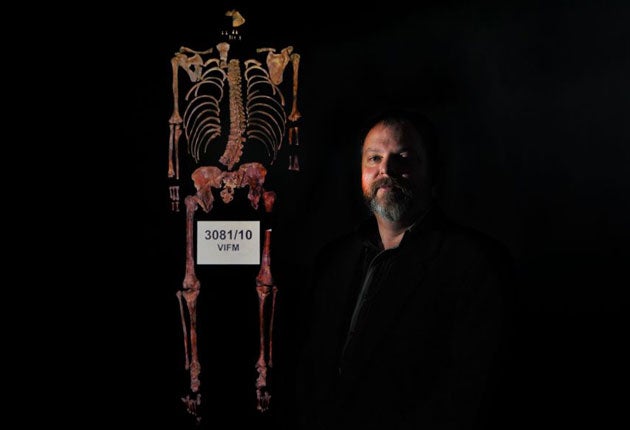Experts identify Ned Kelly remains

Your support helps us to tell the story
From reproductive rights to climate change to Big Tech, The Independent is on the ground when the story is developing. Whether it's investigating the financials of Elon Musk's pro-Trump PAC or producing our latest documentary, 'The A Word', which shines a light on the American women fighting for reproductive rights, we know how important it is to parse out the facts from the messaging.
At such a critical moment in US history, we need reporters on the ground. Your donation allows us to keep sending journalists to speak to both sides of the story.
The Independent is trusted by Americans across the entire political spectrum. And unlike many other quality news outlets, we choose not to lock Americans out of our reporting and analysis with paywalls. We believe quality journalism should be available to everyone, paid for by those who can afford it.
Your support makes all the difference.The headless remains of Australia's most storied criminal, Ned Kelly, have been identified, officials said today, ending a decades-long mystery surrounding the final resting place of a man now seen by many as a folk hero.
Kelly, who led a gang of bank robbers in Australia's southern Victoria state in the 19th century, was hanged in 1880. His corpse's fate was unknown, though it was long suspected his body lay alongside 33 other executed inmates in a mass grave at a prison.
Officials pinpointed the location of the grave site in 2008 and later exhumed the bodies for analysis. A DNA sample from one of Kelly's descendants confirmed that one of the skeletons — which was missing most of its skull — was that of the notorious Ned, said Victoria Attorney General Robert Clark.
"To think a group of scientists could identify the body of a man who was executed more than 130 years ago, moved and buried in a haphazard fashion among 33 other prisoners, most of whom are not identified, is amazing," Clark said in a statement.
Kelly, whose father was an Irish convict, led a gang that robbed banks and killed policemen from 1878-80. These days, he is considered by many Australians to be something of a Robin Hood or Jesse James-like character, fighting the British colonial authorities and championing the rural Irish underclass.
For years, Australians have wondered what became of Kelly's remains. After he was executed at the age of 25, his body was buried in an unmarked grave at a prison called the Old Melbourne Gaol. But when the facility closed in 1929, officials decided to exhume Kelly's body along with the remains of other executed convicts and move them to the nearby Pentridge Prison.
The exhumation, however, turned into something of a debacle when a mob of onlookers descended on the site and stole some of the remains, including what was believed to be Kelly's skull. That skull was later recovered and put on display at the Old Melbourne Gaol — now a historic site — next to Kelly's "death mask," a plaster cast of his face made after his execution.
In 1978, the skull was stolen again. Thirty-one years later, on Nov. 11, 2009, a farmer from Western Australia state named Tom Baxter handed the Victorian Institute of Forensic Medicine what he said was the stolen skull, which featured the inscription "E. Kelly" on its side — Kelly's actual first name was Edward. Baxter has not revealed how he got ahold of the skull.
Scientists at the institute set out to determine who the skull belonged to, and to identify Kelly's full remains among the tangle of skeletons exhumed from the Pentridge site.
Through CT scans, X-rays, anthropological and historical research and DNA analysis, the team finally identified one skeleton as Kelly's. Most of its head was missing.
Stephen Cordner, the institute's director, said the DNA left no doubt the skeleton was Kelly's. Tests on the remains also uncovered evidence of shotgun wounds that matched those Kelly suffered during his criminal rampage.
"The wear and tear of the skeleton is a little bit more than would be expected for a 25-year-old today," Cordner said. "But such was Ned's life, this is hardly surprising."
As for Baxter's "E. Kelly" skull? Not Ned's. The whereabouts of Kelly's skull remain a mystery, Cordner said.
The DNA sample used for comparison came from Leigh Olver, a teacher in the Victoria capital of Melbourne and the great-grandson of Kelly's sister Ellen. On Thursday, he told reporters in Melbourne that he hoped his notorious ancestor will finally be laid to rest in a place of dignity.
"It's such a great relief to finally have this side of the story resolved," Olver said.
Kelly's story has been documented in several books and movies, including a film starring Rolling Stones frontman Mick Jagger and another starring late actor Heath Ledger. Kelly's use of homemade armor to protect himself from police bullets was even given a nod during the 2000 Sydney Olympics, when actors on stilts dressed in similar armor were featured in the opening ceremony.
"I think a lot of Australians connect with Ned Kelly and they're proud of the heritage that has developed as a result of our connection with Ned Kelly and the story of Ned Kelly," Olver said. "In our family, he was a hero."
AP
Join our commenting forum
Join thought-provoking conversations, follow other Independent readers and see their replies
Comments